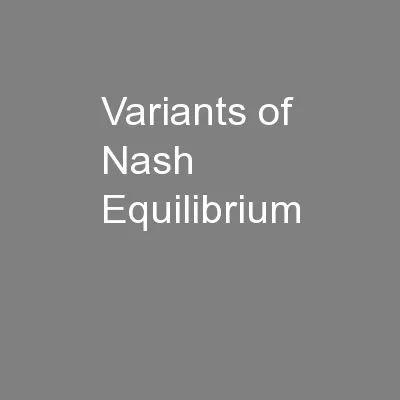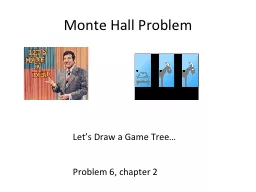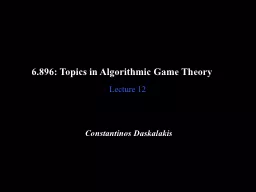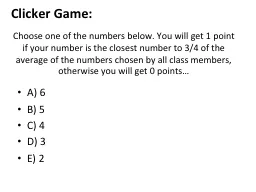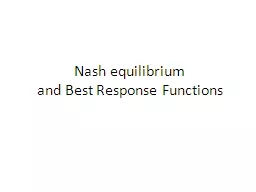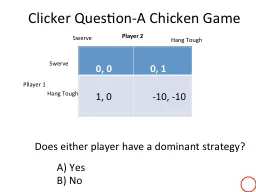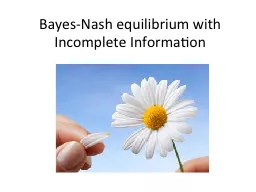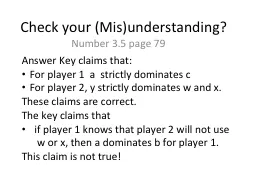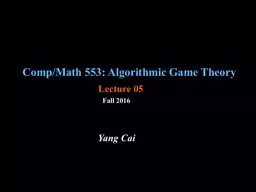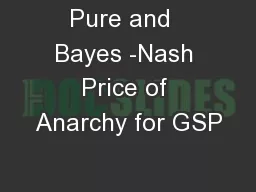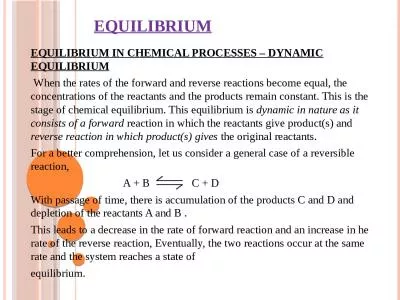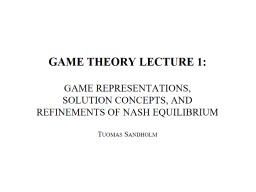PPT-Variants of Nash Equilibrium
Author : olivia-moreira | Published Date : 2016-05-13
CMPT 882 Computational Game Theory Simon Fraser University Spring 2010 Instructor Oliver Schulte 1 Equilibrium Refinements A complex game may have many Nash equilibria
Presentation Embed Code
Download Presentation
Download Presentation The PPT/PDF document "Variants of Nash Equilibrium" is the property of its rightful owner. Permission is granted to download and print the materials on this website for personal, non-commercial use only, and to display it on your personal computer provided you do not modify the materials and that you retain all copyright notices contained in the materials. By downloading content from our website, you accept the terms of this agreement.
Variants of Nash Equilibrium: Transcript
CMPT 882 Computational Game Theory Simon Fraser University Spring 2010 Instructor Oliver Schulte 1 Equilibrium Refinements A complex game may have many Nash equilibria Can we predict which one players will choose. Revision control computer program. Written by Ross Cohen with some design by Bram Cohen. Use Python. Use merging algorithm called “. Codeville. merge”. Used by . BitTorrent. , . Mosuki. Revision control. Let’s Draw a Game Tree…. Problem 6, chapter 2. Information sets in Monte Hall game. In last move, contestant knows which door he chose and which Monte opened. The door that Monte opened is neither the one that contestant opened nor the one with the good prize.. Econ 171. The Hawk-Dove Game. Animals meet encounter each other in the woods and must decide how to share a resource.. There are two possible strategies. . Hawk: Demand the entire resource and be prepared to fight for it.. Lecture 12. Constantinos Daskalakis. The Lemke-. Howson. Algorithm. The Lemke-. Howson. Algorithm (1964). Problem:. Find an exact equilibrium of a 2-player game.. Since there exists a rational equilibrium this task is feasible.. …. A) 6. B) 5. C) 4. D) 3. E) 2. Clicker Game:. Nash Equilibrium. The real John Nash. Hollywood’s Version. Clicker Question-A Chicken Game. . 0, 0. 0,. 1. . 1, 0. . -10, -10 . Econ 171. The Hawk-Dove Game. Animals meet encounter each other in the woods and must decide how to share a resource.. There are two possible strategies. . Hawk: Demand the entire resource and be prepared to fight for it.. and Best Response Functions. . Best response functions and . Nash Equilibrium. The best response function for any player . i. , is a function that maps the list of actions by other players into the list of actions that are best responses to what the others did.. . . 0, 0. 0,. . 1. . 1. , 0. . . -10, -10 . Swerve. Hang Tough. Swerve. Hang Tough. Player 2. Pllayer. 1. Does either player have a dominant strategy?. A) Yes. B) No. What’s . New here?. . Incomplete information: . Example: . Battle of the sexes . game,But. Bob . doesn’t know . what Alice wants . (i.e. her payoffs from possible outcomes). In previous examples we had “. (. Mis. )understanding. ?. Number 3.5 page 79. Answer Key claims that: . For player 1 a strictly dominates c. For player 2, y strictly dominates w and x.. These claims are correct.. The key claims that . Fall 2016. Yang Cai. Lecture . 05. Overview so far. Recap:. Games, . rationality, . solution concepts. Existence Theorems for Nash equilibrium: . Nash’s theorem for general games (via . Brouwer. Renato. . Paes. . Leme. . Éva. . Tardos. Cornell. Cornell & MSR. Keyword Auctions. organic search results. sponsored search links. Keyword Auctions. Keyword Auctions. Selling one Ad Slot. . When the rates of the forward and reverse reactions become equal, the concentrations of the reactants and the products remain constant. This is the stage of chemical equilibrium. This equilibrium is . solution concepts, and . Refinements of NASH Equilibrium. Tuomas Sandholm. The heart of the problem. In a 1-agent setting, agent. ’. s expected utility maximizing strategy is well-defined. But in a multiagent system, the outcome may depend on others.
Download Document
Here is the link to download the presentation.
"Variants of Nash Equilibrium"The content belongs to its owner. You may download and print it for personal use, without modification, and keep all copyright notices. By downloading, you agree to these terms.
Related Documents

